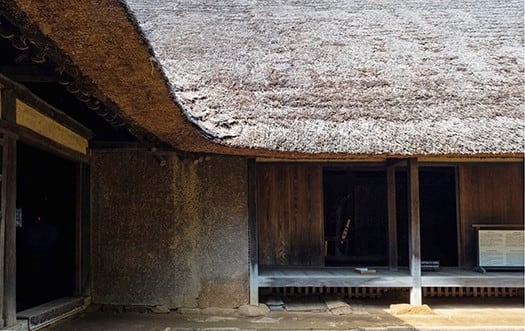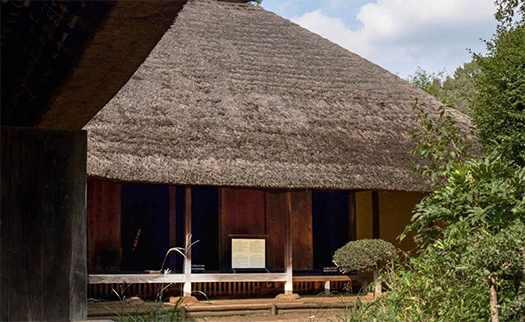



萱葺き屋根は、人類共有性の高い技術として普遍的に存在するけれど、
日本固有の木造建造物を受け継ぐための伝統技術の重要性から
「伝統建築工匠の技」の一つとして2020年11月17日に
ユネスコ無形文化遺産に登録された。
人類定住の最初期、日本列島で言えば縄文時代から連綿として
屋根材としてもっとも初期から使われ続けてきた。
植物としてはストロー状の茎を持った素材全般が使われただろうけれど、
もっとも上質なのは茅とされ、伊勢神宮などでは使われ続けている。
しかし基本的にはその地域地域で入手可能なストロー繊維材が使われる。
茅(ススキやチガヤ、ヨシ(アシ)などの総称)を材料(屋根材)にする。
ただし茅葺き屋根の一部(下地等)には稲藁や麦藁を屋根材に含むことが多い。
茅が水分に強いことは古くから知られていたと考えられている。
屋根材では茅に比べると藁(ワラ)は油分が少なく耐水性に劣るとされる。
しかし茅よりも藁のほうが入手しやすく茅葺き屋根であっても
最下層の下地には藁を用いていることが多い。
〜というような記述がWikipediaなどには見られている。
こういう素材が内部発熱としての薪からの煙で「燻煙」されて
乾燥してより耐久力を高めていったというのが自然な家の歴史。
こういった素材についてまず第一には防水性が有為とされ、
ついで断熱性が基本的な着目ポイントであったことが疑いない。
このような屋根材と現代住宅の関連性で言えば、
やはりトタン葺きとグラスウールとの類縁性がもっとも想起される。
板金素材は人工的に作り出された材料・金属材として合理的な
屋根に求められる性能条件を満たしたのだろうし、
グラスウール断熱材は、萱葺き屋根素材の静止空気保存性能を
さらに飛躍的に高めた素材として近代工業製品化された。
そして家の布団ワタのように利用されてきたというのがシンプルな住宅史。
板金素材は瓦などの窯で土・砂などの高熱処理をする窯業素材が
その先人として存在したが、近代工業社会で鉄生産が普遍化して
鉄板屋根・トタン板金として圧倒的に普及してきた。
グラスウールもまたプラスチック系の断熱素材が後追いしてきたけれど、
圧倒的な多数派を形成して今日に至っているといえるでしょう。
いずれにしても、現代住宅はこの萱葺き屋根がすべてのルーツといえる。
今日、萱葺き屋根の住宅はドイツなどでは高級住宅の意匠として
さかんに建築されてきているという。
他の断熱材が石油化学由来の素材であるのに対して自然素材そのままであり
エコロジー思想を突き詰めていくのに整合的だと思われているようです。
高級住宅であるのには、その維持のための費用を厭わないという
エリート意識がその根底にあるのだろうと思われます。
日本でも石巻市は北上川河川流域で茅が生産されることもあって
地場材振興を狙い茅葺き屋根の建築が可能なように条例整備している。

この南部曲り家では当然、屋根の「谷」が出来上がるけれど、
その防水的・積雪的弱点を補強するように
たいへん重厚な萱葺きの重ね厚みが感じられる屋根形状。
また、その必然的な曲面状況がなだらかなカーブを見せて
独特のデザイン的愛惜感が伝わってくると思います。
いわば「民族の母性」がこのデザインから伝わってくるように感じる。
English version⬇
[Thatched roof design / Japanese good house ㉗-9]
Thatched roofs are universally present as a technology that is highly shared by humankind.
From the importance of traditional techniques to inherit Japanese wooden structures
November 17, 2020 as one of the "traditional architectural craftsmanship"
It was registered as a UNESCO Intangible Cultural Heritage.
The earliest settling of humankind, in the Japanese archipelago, as a continuous cotton from the Jomon period
It has been used as a roofing material from the very beginning.
As a plant, all materials with straw-shaped stems would have been used,
The highest quality is said to be Kaya, and it continues to be used at Ise Jingu and other places.
However, basically, straw fiber materials available in the area are used.
Kaya (general term for Japanese pampas grass, Imperata cylindrica, Yoshi (Ashi), etc.) is used as the material (roofing material).
However, part of the thatched roof (base, etc.) often contains rice straw or wheat straw as the roofing material.
It is believed that Kaya has long been known to be resistant to moisture.
It is said that straw has less oil and is inferior in water resistance as a roofing material compared to Kaya.
However, straw is easier to obtain than thatched roof, even if it has a thatched roof.
Straw is often used as the base of the bottom layer.
Descriptions such as ~ can be found on Wikipedia and other media.
These materials are "smoked" by the smoke from firewood as internal heat generation.
The history of a natural house is that it has become dry and more durable.
First of all, waterproofness is considered to be effective for these materials.
Next, there is no doubt that heat insulation was the basic point of interest.
Speaking of the relationship between such roofing materials and modern houses,
After all, the affinity between galvanized iron and glass wool is most recalled.
Sheet metal material is rational as an artificially created material / metal material
It probably met the performance requirements for the roof,
Glass wool insulation provides static air storage performance for thatched roof materials
It has been commercialized as a modern industrial product as a material that has been dramatically enhanced.
And it is a simple history of housing that it has been used like a futon cotton in a house.
The sheet metal material is a ceramic material that heat-treats soil, sand, etc. in a kiln such as roof tiles.
Although it existed as its predecessor, iron production became universal in the modern industrial society.
It has become overwhelmingly popular as an iron plate roof and galvanized iron sheet metal.
Glass wool has also been followed by plastic insulation,
It can be said that it has formed an overwhelming majority and continues to this day.
In any case, this thatched roof is the root of all modern houses.
Today, thatched-roof houses are used as a design for luxury houses in Germany and elsewhere.
It is said that it has been built extensively.
While other insulation materials are derived from petrochemicals, they are natural materials as they are.
It seems to be consistent in pursuing ecology ideas.
It is said that even though it is a luxury house, it is willing to pay for its maintenance.
It seems that elite consciousness is at the root of it.
Even in Japan, Ishinomaki City is sometimes produced in the Kitakami River basin.
Ordinances have been put in place to enable the construction of thatched roofs with the aim of promoting local materials.
Naturally, a "valley" on the roof is created in this southern bender,
To reinforce its waterproof and snow-covered weaknesses
The roof shape that you can feel the layered thickness of a very heavy thatched roof.
Also, the inevitable curved surface shows a gentle curve.
I think you can feel the unique design of love.
So to speak, I feel that "ethnic motherhood" is transmitted from this design.



















